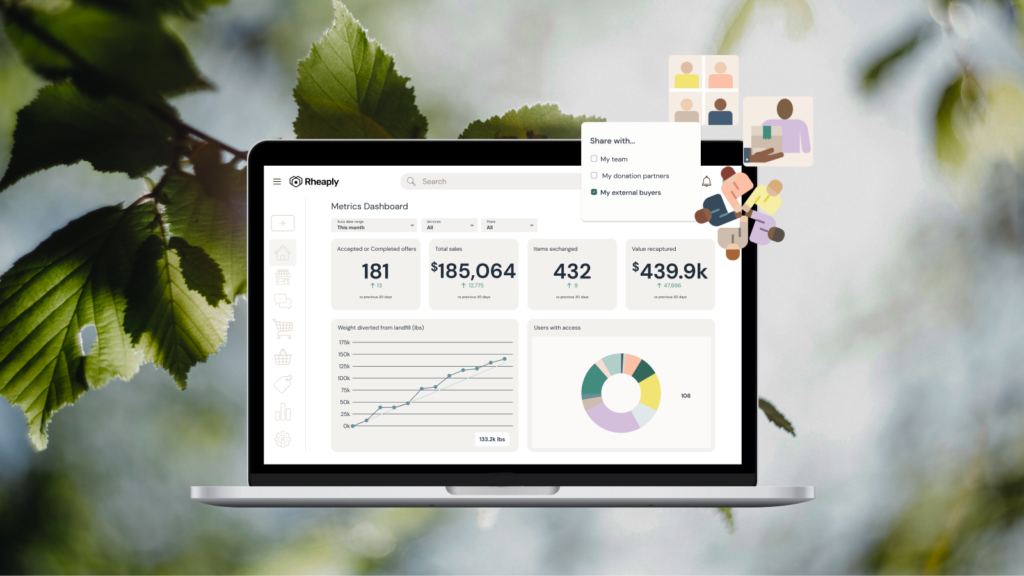This post is a syndication from Rheaply CEO and Co-founder Garry Cooper’s LinkedIn Newsletter “The Sustainable Business” which you can subscribe to here.
“Moral cowardice.” “Highway to hell.” “Cooperate or perish.” “You might as well bomb us.” These were phrases not-so-loosely tossed around at COP27 (the United Nations Climate Change Conference) earlier this month, and I get why leaders and advocates are using them – the alarm bells have been ringing for a while now as the climate fight rages on, and this year carbon emissions are projected to hit a new high. Progress, it seems, still eludes us.
These “Doomsday Takes” were the norm as 30,000 delegates navigated through the venue. The fact that this year’s conference was hosted at the Tonino Lamborghini International Convention Center – a Vegas-like resort in Sharm el-Sheikh, Egypt — certainly made discussions around overconsumption, loss, and damage control a bit more… real.
Discussions ranged from climate financing for developing countries – essentially, wealthy countries taking ownership and paying for the destruction that climate has caused elsewhere – to formal declarations on mining and energy transition. The apocalyptic rhetoric (and the often mind-blowing numbers that accompany it) wasn’t limited to difficult carbon reduction or sustainability goals, or the perils of overshooting 1.5°C. There were sobering financial projections as well. The estimated cost of the private sector funding the climate priorities in developing economies requires companies to “cut emissions, boost resilience, deal with damage from climate change and restore nature and land” — will be close to $1 trillion per year by 2030.
All in all, COP27 hit us with a whole lot of doom and gloom. Those sentiments are certainly understandable, given the scale of the climate crisis. But it also got me questioning the effectiveness of this type of messaging.
What if we reversed our thinking on the daunting task of reversing climate change?
If we looked back through history, can we find positive messaging affecting sustainable change even more so than negative messaging? We don’t have to look very far for answers.
Example 1: Jane Goodall – addressing the continued loss of biodiversity
One of the highlights of my year was seeing Dr. Jane Goodall speak at Dreamforce in September. Dr. Goodall famously said, “The best days of my life were when I could spend hours in the rainforest and learn how everything was interconnected in this wonderful tapestry of life.” It’s a thought that doesn’t exactly inspire Doomsday panic, but it served as the foundation for some of the most impactful environmental progress of our time. Dr. Goodall took her groundbreaking research on the interconnection between humans and animals in a direction that profoundly changed the way we view the importance of protecting biodiversity: her research led us to now understand that investment in biodiversity recovery yields planetary benefits manyfold higher. (A Goldman Sachs report from this year estimated that “each dollar invested in biodiversity may yield up to $30 in net societal benefits.”)
Example 2: Interface – doing well by doing good
Let’s bring it closer to home with the readers here, many of whom work in the commercial sector. When the circular economy wasn’t on the radar – or rather, even in its infancy — the late, great CEO of Interface, Ray Anderson, challenged the status quo of the purpose of businesses and authored “The Prototypical Company of the 21st Century.” Inspired by Paul Hawken’s “The Ecology of Commerce,” Anderson gave his own company – a billion dollar global carpet business – no choice but to become a sustainable business: restorative or regenerative by intention and design. (And this was in 1994!) The results were (and still are) profound, even in the face of several pivots and speed bumps. While work still remains, I encourage you to request a screening of Interface’s incredible new documentary, Beyond Zero — members of my team at Rheaply got to see a screening at San Francisco’s Museum of Modern Art, kicking off the 20th anniversary festivities of Greenbuild, and it is truly incredible.
Example 3: Addressing the vacant building and housing crisis with adaptive Reuse
If you’ve read this newsletter in the past, you will know how much I enjoy adaptive reuse and examples of preservation in the built environment. With nationwide vacant buildings and the housing crisis as a backdrop, cities like New York, Los Angeles, Philadelphia, and my hometown of Chicago are relaxing building rules and adding incentives for property owners to convert vacant office property into affordable housing. Adaptive reuse apartments have skyrocketed 25% over the past two years, compared to a 10% increase in newly-constructed apartments. In Philadelphia, converted units have nearly quadrupled since 2010, from 5,271 to 20,122 by the end of 2021. These cities have taken proactive, strategic action to build (literally) a more sustainable future.
Moving from fear to climate positivity
In all of these cases, was it about avoiding a doomsday scenario, or showing what happens if we create a better world to catalyze broader climate action? At a consumer level, fear might work; as seen above, it takes leadership and positivity to move organizations towards climate success.
In truth, enacting effective climate action probably requires a balance of both positive and negative. A fundamental understanding of the civilizational threats is necessary to set the stakes, but the real magic is what happens after. Once we understand the depths of the problem, we must act quickly to understand how simple actions can work towards solving it. And we can do so with the knowledge that we don’t have to choose between “doing good” and “doing well” — sustainability efforts aren’t simply desperate attempts to avoid disaster; they go hand-in-hand with sound economic practices.
To that end, I’d like to close by returning to that daunting $1T climate financing figure again from earlier in the piece. We typically see gaudy numbers like this as a sobering threat, but this one should represent an opportunity. We know we can mobilize that type of financial commitment when motivated (our global response to the Covid-19 crisis cost $9T); we can do it again. Therefore, that $1T figure can be a beacon of hope, one that Ray Anderson would fervently support — but only if the captains of our industry are ready to start somewhere.
So instead of focusing on the twists and turns of our current “highway to hell,” who is ready to build the highway out of climate hell?



